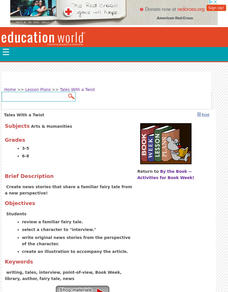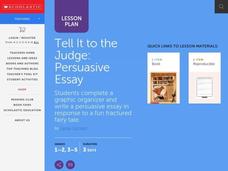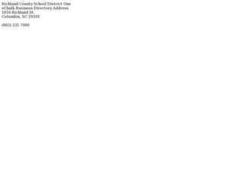Curated OER
Tales with a Twist
Your authors create news stories that share a familiar fairy tale from a new perspective. They review a familiar fairy tale, select a character to "interview," and write original news stories from the perspective of that character.
Curated OER
Health Education: Opinions
Third graders consider the opinions of others. In this personal health lesson plan, 3rd graders demonstrate how to effectively and respectfully express opinions that differ from others as they create and follow rules for productive...
Curated OER
Plot Summaries
In this plot summaries worksheet, middle schoolers read the plot summaries and write what the expositions, inciting moments, rising actions, climaxes, falling actions, and denouements are in them. Students do this for 2 plot summaries.
Curated OER
The Big, Bad Wolf
Seventh graders analyze the stereotyping of wolves in children's literature. They compare stereotypes and facts about wolves. They rewrite a fairy tale from the wolf's point of view.
Curated OER
Real and Fictional Wolves
Students demonstrate understanding of the difference between real and fictional wolves through critical reading and comparisons while using a Venn Diagram.
Ingram
Teaching Guide Charlotte's Web
Enrich your study of Charlotte's Web by E.B. White with this useful resource. Included here are 22 discussion questions, 15 extension ideas, and 10 curriculum questions that cover characters, plot, farming, and much, much more.
Curated OER
Tell It to the Judge - Persuasive Essay
Students compare and contrast a classic fairy tale with a fractured one and complete a graphic organizer. Then they write a persuasive essay following the steps of the writing process. Finally, students publish their completed essay and...
Curated OER
Comparing and Contrasting Literature Using Venn Diagrams
First graders create a venn diagram with two folktales. In this folktale activity, 1st graders read Cinderella and Mufaro's Beautiful Daughters by John Steptoe. They find the similarities and differences and chart these on a venn diagram.
Curated OER
Sorting
Learners practice sorting books. For this sorting lesson, students play the Flood Game on the PBS web site. With knowledge of the sorting system used by libraries, learners sort small numbers of books using categories devised by their...
Curated OER
Folktale Unit: Pecos Bill
Students experience a shared reading of Steven Kellogg's, Pecos Bill, while learning the associated vocabulary. They examine similarities and differences in folktales and discuss what a hero is. Finally, journal about their favorite part...
Curated OER
Folktale Unit
Students read different types of folktales. They participate in many activities in which they examine characters found in the tales. They create their own folktales and shares them with the class.
Curated OER
Folktale Unit: Paul Bunyan and the Big Blue Ox
Young scholars participate in a shared reading of Steven Kellogg's, Paul Bunyan while learning the associated vocabulary. They write a journal entry expressing which of the folktales they have read is their favorite and why.
Curated OER
Learning the Component and Information Found in the Newspaper
Fifth graders work in a group to identify and reference the index, front page, metro page, state and local pages, as well as the sports, comics and classifieds in the newspaper 90% of the time during the game of "Identifying and...
Curated OER
Sentence Structure Grammar on Noun and Verb
In this grammar activity worksheet, students rewrite sentences by correcting the punctuation mistakes. Students also identify the nouns and action verbs in each sentence. Students complete 7 sentences.
Curated OER
Acting on the Farm
Second graders are assigned reading and acting parts by drawing out pieces of paper with an animal. They find their group by making the sound of the animal once everyone has drawn a paper. They then read and choose parts within their...
Curated OER
Reading, Writing, and Rhyming
Students listen to four different nursery rhymes and list characteristics that are common among nursery rhymes. They access the Internet to find ten nursery rhymes and record the web address. They choose a nursery rhyme and re-tell it...
Curated OER
Heeeeeere's Pea O'Vee!
Fourth graders assume the roles of characters in familiar fairy tales and participate in a panel discussion using a talk show format.
Curated OER
Materials 1: Materials and Manufacturing
Pupils examine the properties, limitations, and durability of a variety of materials, then evaluate which of the materials would be best for building a model house. If used in its entirety, this lesson could take several science class...
Curated OER
Aspects of Participatory Citizenship
Students research the current issues about the government of Canada and develop their presentation skills.
Curated OER
Ready, Set, Read!
Students observe a sentence as it is written on the board and listen as it is read to them twice. They choose which reading of the sentence they prefer; the first time it is read slowly with some words sounded out and the second time...
Other
Critical Thinking Consortium:true Story of Three Little Pigs (Guide) [Pdf]
This is a teacher's guide for The True Story of the Three Little Pigs by Jon Scieszka. AFter reading the story, students will examine the evidence to determine if the wold is being truthful. Blackline masters and a rubric are included.
Better Lesson
Better Lesson: Discussing "The True Story of the Three Little Pigs"
In this lesson, 1st graders will work with "The True Story of the Three Little Pigs" Jon Scieszkaby. They will describe the characters, setting, and key details in the story and help the teacher record the details on a circle map.
Read Works
Read Works: Paired Text Questions: "The True Story of the Three Little Pigs"
[Free Registration/Login Required] Compare and Contrast two versions of "The True Story of the Three Little Pigs". Lesson plan and student questions are included.
Chase Young, PhD
Dr. Chase Young, Ph D: Reader's Theater Script: The True Story of the Three Little Pigs
Improve students' reading fluency while providing fun and purposeful practice and performance through Reader's Theater Scripts. The focus is on reading the text with expressive voices and gestures - no memorization required! Have fun...






















![Critical Thinking Consortium:true Story of Three Little Pigs (Guide) [Pdf] Unit Plan Critical Thinking Consortium:true Story of Three Little Pigs (Guide) [Pdf] Unit Plan](https://d15y2dacu3jp90.cloudfront.net/images/attachment_defaults/resource/large/FPO-knovation.png)

